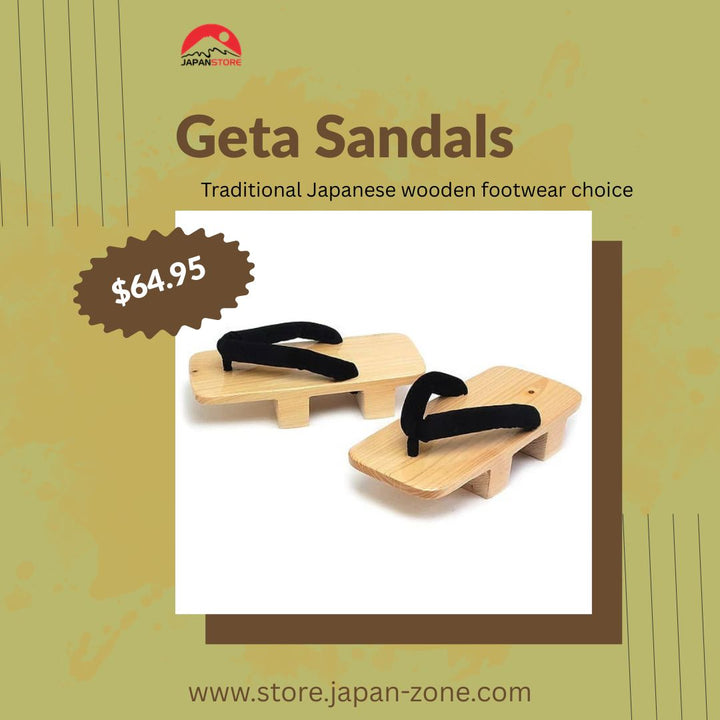At Japan Store, we believe footwear isn’t just about style—it’s about health, posture, and how you feel all day long. In this blog post, we’ll explore the many advantages of choosing Japanese geta sandals and zori sandals for your everyday walking. We’ll cover how these traditional styles support foot-strengthening, posture improvement, and overall vitality.
Both Japanese geta sandals and zori sandals are highlighted here, with special attention to their health benefits when incorporated into daily wear.
What Are Japanese Geta Sandals and Zori Sandals?
Before exploring the health benefits, it's helpful to understand what these types of footwear are.
Japanese Geta Sandals
The term “Japanese geta sandals” refers to traditional wooden sandals characterized by a flat wooden base and two “teeth” (raised blocks) under the sole.
- The elevated design helped keep feet and long garments off dirty or wet ground.
- Because of the raised “teeth” and the thong strap between the big toe and second toe, walking in geta creates a distinctive gait.
- Modern versions of geta incorporate rubber soles or new materials for comfort and use beyond traditional wear.
Zori Sandals
Zori sandals are another traditional Japanese form of footwear, typically flatter than geta and originally made from straw, rush or other plant materials.
- Designed for easy slip-on / slip-off, suited to a culture where shoes are removed when entering homes.
- Zori have been shown in research to help with lower-leg function (especially among older users) by improving walking stride and toe engagement.
- They carry both cultural significance and functional advantages (especially for circulation and foot development).
Health Benefits of Walking in Japanese Geta Sandals!
There are distinct benefits associated with wearing Japanese geta sandals—and when used consciously for daily wear, you can gain more than just style.
Better Foot Engagement & Muscle Activation
Walking in Japanese geta sandals encourages your toes to grip the thong strap between big toe and second toe. This can:
- Stimulate the plantar fascia and toe muscles.
- Promote stronger arches and reduce flat-foot risk, because your toes must press slightly to keep the sandal in place and maintain balance.
- Engage lower leg and foot muscles more than typical cushioned sneakers. For example, research on geta found improved toe and foot muscle activation.
Improved Posture & Balance
Traditional geta design naturally encourages a more upright stance and alert gait:
- Because of the elevated base, the body’s weight tends to shift slightly forward, which may promote better alignment of spine, hips and shoulders.
- The balancing act required when walking with “teeth” under the sandal base tends to improve ankle stability and proprioception (your sense of where your body is in space).
- Good posture reduces undue stress on lower back and hips—making a traditional pair of geta a subtle tool for wellness.
Enhanced Circulation & Foot Health
Several sources highlight how wearing geta (and zori) can enhance circulation and overall foot health:
- A study of modern geta found that just 30 minutes of walking improved blood circulation in the soles of the feet.
- Traditional open sandal designs allow for better air flow, reducing sweat accumulation and foot-skin stress—especially in humid environments.
- Because the feet are less confined than in stiff closed shoes, there’s less risk of toe-cramping, constrained foot-movement or pressure build-up.
Encourages Natural Gait Mechanics
- Walking in Japanese geta sandals means you’re less reliant on heavy cushioning and more reliant on the natural motion of your feet and ankles. This can lead to a more efficient stride.
- The “toe-pinch” motion helps correct floating-toe problems (where toes don’t make full contact with the ground) by forcing more toe engagement.
Bonus: Mindful Walking Experience
Wearing traditional footwear slows you down in a positive way. Because you become more aware of each step, heel strike, toe off—this brings a more mindful posture and walking rhythm. The gentle clack of geta underfoot becomes a rhythm of its own.
Health Perks of Walking in Zori Sandals
While much of the attention goes to geta, zori sandals also hold valuable health benefits—especially when used properly for daily walking.
Improved Lower-Leg Function
- A scientific intervention found that elderly women wearing zori achieved increased walking speed, longer stride lengths and higher tip-toe height compared to baseline.
- The design forces a slightly different pressure distribution underfoot—which can help maintain muscle function and balance in the lower legs.
Foot Development & Arch Strength
- One Japanese children’s-foot study noted that children wearing zori had stronger foot arches and fewer instances of flat feet compared to peers wearing other shoes.
- Because zori let toes spread and feet move more freely, they promote intrinsic foot strength and natural foot mechanics.
Natural Ventilation & Comfort
- Zori’s relatively flat soles and open design mean the feet are less compressed, less heated, and less prone to moisture build-up than closed-toe shoes in warm climates.
- In a culture of frequent shoe removal and re-entry (as in Japan), the easy slip-on nature of zori makes them convenient yet health-oriented.
Versatility for Daily Wear
While originally designed for formal wear with kimono, today modern zori models incorporate contemporary comfort features (rubber soles, padded straps). They can bridge tradition and function for casual use.
How to Incorporate Japanese Geta Sandals & Zori Sandals into Your Daily Routine?
At Japan Store we’re excited to help you make the most of these traditional footwear styles. Here are practical tips on integrating Japanese geta sandals and zori sandals into everyday life—with comfort and health in mind.
Start Slowly
- Because both geta and zori engage your feet differently than cushioned sneakers, begin with shorter walking periods.
- Let your toes adjust to the thong between the big and second toe (common for both).
- Choose a day when you’ll be walking moderate distances, not all day on the first try.
Choose the Right Style for Your Use
- If you prefer more elevated support and a distinctive look, Japanese geta sandals are excellent.
- If you want something flatter and more flexible for walking around town, zori sandals may be more suitable.
- Ensure good fit: For geta, look for stable “teeth” and balanced platform; for zori, check that your foot is securely on the base and the thong strap is comfortable.
Consider Your Walking Surface & Activity
- On smooth pavements, either can work—but if you expect uneven terrain, opt for a model with rubber soles or modern modifications for grip.
- For longer walks, hybrid versions of geta or zori with cushioning or support may be more forgiving.
Mind Your Posture
- When wearing geta, consciously stand tall: shoulders back, abdominal core slightly engaged, toes gently gripping the strap.
- With zori, allow your toes to spread naturally and feel the ground beneath your soles.
- Pay attention to your stride: let your heel strike lightly, roll forward and lift off with your toes.
Foot Care & Break-In
- After wearing, stretch your feet and toes to release any tension.
- If you feel soreness, scale back duration and increase gradually.
- Clean the soles and straps regularly—wood and straw materials can accumulate dirt and reduce comfort.
- Alternate your footwear—don’t wear them every day initially so your feet adapt gradually.
Why Shopping at Japan Store Matters?
When you choose Japan Store, you’re not just buying footwear—you’re investing in tradition, health and craftsmanship.
- We offer authentic styles of Japanese geta sandals and zori sandals—so you can shop with confidence.
- You’ll find a selection that ranges from classic to modern hybrids—letting you find the balance of style + function.
- We provide guidance on sizing and materials so you can select sandals that suit your daily walking needs.
- With proper care and wear, your pair from Japan Store will give you not only aesthetic satisfaction but real wellness benefits.
Frequently Asked Questions (FAQs)
Q1: Are Japanese geta sandals comfortable for everyday walking?
A: Yes—with the right fit and gradual break-in, Japanese geta sandals can be comfortable for daily wear. They engage foot muscles more actively and promote posture, but initially walking in them may feel different than modern sneakers. Studies show foot and circulation benefits when used appropriately.
Q2: Can zori sandals replace my regular shoes?
A: Zori sandals can be used for casual daily wear and offer foot‐health benefits (especially below the knee). They may not always provide the same cushioning or arch support as modern athletic shoes, so consider your walking distance and surface. But they are an excellent complementary footwear choice.
Q3: Do I need to wear socks with geta or zori?
A: Traditionally, geta might be worn with “tabi” socks (split-toe) especially in formal settings; zori often similarly. For casual daily use, many wear them barefoot or with no socks, depending on comfort and weather. This freedom helps foot ventilation and natural movement.
Q4: How do I choose between Japanese geta sandals vs zori sandals?
A: Consider your use case:
- Choose Japanese geta sandals if you want more elevation, pronounced posture cues and foot-muscle engagement.
- Choose zori sandals if you prefer flatter, simpler design, easier slip-on/off and a gentler transition from regular sandals.
Also check materials, sole thickness and strap comfort.
Q5: Are there any caveats or things to watch out for?
A: Yes. Because both styles place different demands on your feet:
- They might take adjustment time—your foot muscles may feel more fatigue at first.
- Improper size or too-hard base might cause discomfort especially under the ball of the foot or near the thong strap.
- For very long walking distances or uneven terrain, you may prefer a more cushioned shoe or a hybrid version of these sandals.
Conclusion
Walking in Japanese geta sandals and zori sandals offers more than just a distinctive look—it supports healthy foot mechanics, improved posture, better circulation and a more mindful walking experience. At Japan Store, we’re proud to offer these traditional-inspired sandals that blend culture with comfort and wellness.
By choosing the right style, fitting them carefully, and using them thoughtfully in your everyday routine, you can step into not just style—but lasting comfort and health. If you’re ready to embrace a footwear option that aligns with traditional design and modern wellness, consider exploring our collection of Japanese geta sandals and zori sandals today. Your feet—and your posture—will thank you.





